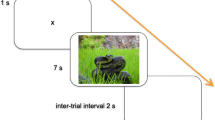Abstract
Speech phobic subjects prepared and presented two speeches with an interpolated phobic imagery task. During the imagery task subjects imagined a phobic stimulus scene followed by scene elaboration describing the subjects' responses to the situation. Phobic stimulus scenes were identical for all subjects, with only the response elaboration varying. For one-third of the subjects depicted response elaboration involved behaving in a relaxed and competent fashion; one-third imagined being anxious and performing incompetently; one-third visualized avoiding the phobic situation. Three stimulusresponse pairs were each presented three consecutive times. Half of the subjects in each imagery condition were given positive expectations regarding the likely effect of the imagery procedure on their speech fear, while half were given neutral expectations. Response imagery was significantly related to rate of subjective fear reduction within and across phobic image presentations, while expectancy influenced fear reduction on both subjective and heart rate measures during the imagery task.
Similar content being viewed by others
Reference Note
1. Borkovec, T. D. Cognitive extensions of two-factor theory. Symposium paper presented at the Ninth Annual Meeting of the Association for the Advancement of Behavior Therapy, San Francisco, December 1975.
References
Borkovec, T. D. Heart rate process during systematic desensitization and implosive therapy for analogue anxiety.Behavior Therapy 1974,5 636–641.
Borkovec, T. D., Grayson, J. B., & Cooper, K. Treatment of general tension: Subjective and physiological effects of progressive relaxation.Journal of Consulting and Clinical Psychology, in press.
Borkovec, T. D., & O'Brien, G. T. Methodological and target behavior issues in analogue therapy research. In M. Hersen, R. M. Eisler, & P. M. Miller (Eds.),Progress in behavior modification. New York: Academic Press, 1976.
Geer, G. H. The development of a scale to measure fear.Behaviour Research and Therapy 1965,3 45–53.
Husek, T. R., & Alexander, S. The effectiveness of the Anxiety Differential in examination stress reactions.Educational and Psychological Measurement 1963,23 309–318.
Lader, M. H., & Mathews, A. M. A physiological model of phobic anxiety and desensitization.Behaviour Research and Therapy 1968,6 411–421.
Lang, P. J. Imagery in therapy: An information processing analysis of fear.Behavior Therapy, in press.
Lang, P. J., Melamed, B. G., & Hart, J. A psychophysiological analysis of fear modification using an automated desensitization procedure.Journal of Abnormal Psychology 1970,76 220–234.
Lazovic, A. D., & Lang, P. J. A laboratory demonstration of systematic desensitization psytherapy.Journal of Psychological Studies 1960,11 238–247.
Lick, J., & Bootzin, R. Expectancy factors in the treatment of fear: Methodological and theoretical issues.Psychological Bulletin 1975,82 917–931.
Meichenbaum, D. Cognitive modification of test anxious college students.Journal of Consulting and Clinical Psychology 1972,39 370–380.
Paul, G. L.Insight vs. desensitization in psychotherapy. Stanford: Stanford University Press, 1966.
Rosen, G. M. Subjects' initial therapeutic expectancies and subjects' awareness of therapeutic goals in systematic desensitization: A review.Behavior Therapy 1976,7 14–27.
Sides, J. K. The roles of relaxation and expectancy in systematic desensitization: Effects on subjective fear and heart rate during and after therapy. Unpublished honors thesis, University of Iowa, 1977.
Stampfl, T. G., & Levis, D. J. Essentials of implosive therapy: A learning-based psychodynamic behavioral therapy.Journal of Abnormal Psychology 1967,72 496–503.
Weinberg, N. H., & Zaslove, M. Resistance to systematic desensitization of phobias.Journal of Clinical Psychology 1963,19 179–181.
Author information
Authors and Affiliations
Additional information
This study was based on a thesis submitted by the first author to the University of Iowa in partial fulfillment of the masters degree requirements and was supported by NIMH Grant MH27484 awarded to the second author.
Rights and permissions
About this article
Cite this article
Grayson, J.B., Borkovec, T.D. The effects of expectancy and imagined response to phobic stimuli on fear reduction. Cogn Ther Res 2, 11–24 (1978). https://doi.org/10.1007/BF01172509
Issue Date:
DOI: https://doi.org/10.1007/BF01172509




